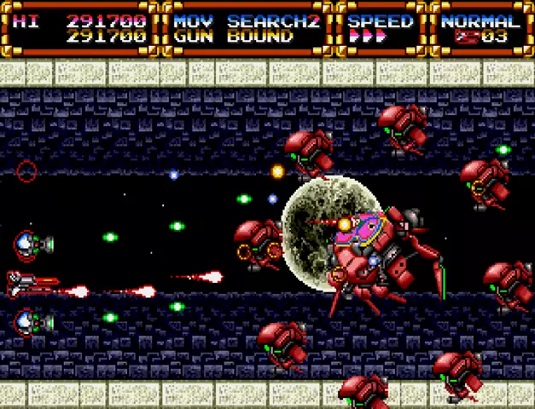
All this struck me as I was playing though Gley Lancer, the 30-year-old Mega Drive shooter recently given a new lease of life on modern systems. As the system was, in its day, arguably the best console for scrolling shoot 'em ups, Gley Lancer stood out from the crowd for several reasons. Its play mechanics, the (mostly) quality graphics and decent sound engine and, a boon or a curse depending on your preferences, its difficulty - or lack thereof. This makes it somewhat unique on Sega's black box considering other entries into the horizontal blaster genre, like Hellfire and Gynoug pack a hefty challenge.
As games go, Gley Lancer brings two new mechanics to the party. The first is adjustable speed. Tradition up to this point had it that one's spaceship starts out as slow as a three-wheeled Lada and becomes zippy through the collection of speed power ups. Not here. The default setting is slow, but a press of the button allows the ship to speed up and slow down. Handy for later in the game when there are flying blocks and platforms to negotiate. The other are the options. At the beginning of the game you're given the choice about how your add-ons should fire. Should they automatically target the nearest enemy? Should they fire in the opposite direction your craft is moving? Should they circle the ship and fire forwards? There are more combinations, and inevitably everyone will have their own preferences. Interestingly, building on this gimmick is what the Switch and PlayStation 5 versions have done. Twin stick controls means the direction of fire can be guided by the second stick, and the patterns can be changed on the fly (along with other mod cons like rewinding the game, and sticking on the scanline shader).
Unlike other shooters, there's a strong focus on plot. For most it's a throw away excuse for framing an exercise in explosions and violence, but here it cannot be escaped. There are cut scenes galore done in the customary anime style in which you, Lucia Cadbrock, absconds with the Gley Lancer to rescue Dad from the evil, anonymous aliens. They can be skipped in-between intervals of levels, but the lengthy sequence at the end of the game cannot. For some reason, games with extensive cut scenes do command a premium on the retro market, and a copy of the original release will knock you back at least £200.
The rest, however, is fairly standard fare. Shoot the baddies, collect the power ups (spread shot, bounce shot, short range powerful shots, lasers, you know the drill), see off the end-of-level guardian. Rinse and repeat. It's very straightforward. Except for the first level, which shades into the annoying. Within seconds you're thrown into a shower of rocks and space debris that are indestructible, all the while the lovely parallax background of more asteroids clips along at a fair pace. This makes discerning objects very difficult. But apart from that, it's plain sailing from that point on. There are some nice-looking levels and stylish bosses, but it's all so very easy. Apart from the end-of-game baddy these bosses are the very opposite of a bullet sponge. If you so much breathe on them they expire, which is a shame as there is potential here for good, challenging confrontations with well-drawn and well-animated bad 'uns. All accompanied by a technically accomplished but a not very memorable sound track.
And this is where we get back to the issue we began with. Gley Lancer is an entertaining enough shooty romp across 11 levels. The two mechanical innovations make for an interesting experience (as well as being left wondering why more successive shooters didn't adopt them), and while not a technical masterpiece it is well-programmed, and the attention to detail is suggestive that it was a labour of love for some on the coding team. And if they've done a good job, why not show it off? The decision to make the bosses super easy, how the player is untroubled, and how higher difficulty levels are available if the game is completed suggests the production crew wanted to put everything they had created out on display. Or if not display, within reach of most players. Therefore, in playing Gley Lancer you'll get to experience all that it offers. The problem lies in whether you'd want to do it much after you've been through it once or twice.
Image Credit
No comments:
Post a Comment